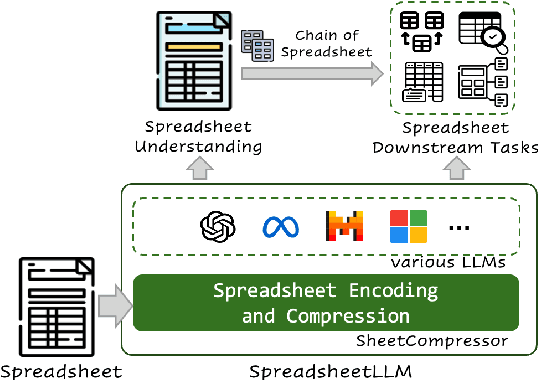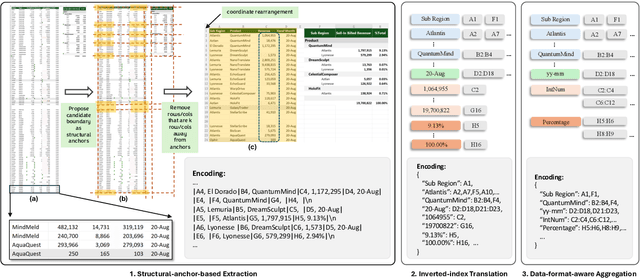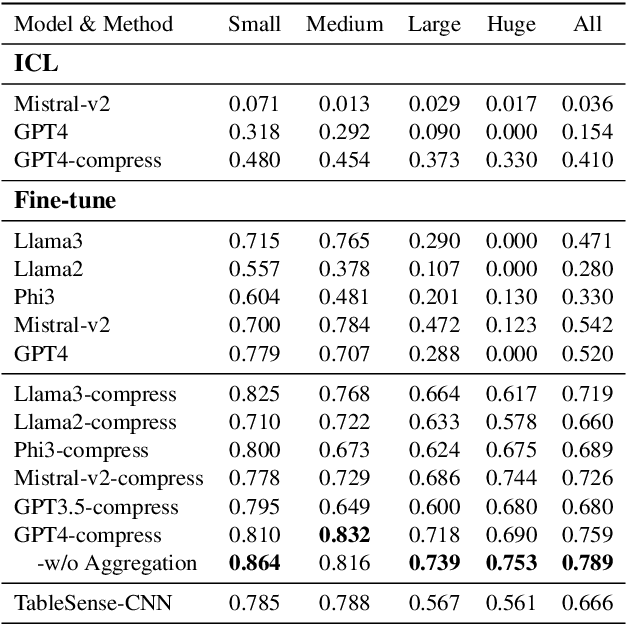Mengyu Zhou
TwT: Thinking without Tokens by Habitual Reasoning Distillation with Multi-Teachers' Guidance
Mar 31, 2025Abstract:Large Language Models (LLMs) have made significant strides in problem-solving by incorporating reasoning processes. However, this enhanced reasoning capability results in an increased number of output tokens during inference, leading to higher computational costs. To address this challenge, we propose TwT (Thinking without Tokens), a method that reduces inference-time costs through habitual reasoning distillation with multi-teachers' guidance, while maintaining high performance. Our approach introduces a Habitual Reasoning Distillation method, which internalizes explicit reasoning into the model's habitual behavior through a Teacher-Guided compression strategy inspired by human cognition. Additionally, we propose Dual-Criteria Rejection Sampling (DCRS), a technique that generates a high-quality and diverse distillation dataset using multiple teacher models, making our method suitable for unsupervised scenarios. Experimental results demonstrate that TwT effectively reduces inference costs while preserving superior performance, achieving up to a 13.6% improvement in accuracy with fewer output tokens compared to other distillation methods, offering a highly practical solution for efficient LLM deployment.
TablePilot; Recommending Human-Preferred Tabular Data Analysis with Large Language Models
Mar 17, 2025Abstract:Tabular data analysis is crucial in many scenarios, yet efficiently identifying the most relevant data analysis queries and results for a new table remains a significant challenge. The complexity of tabular data, diverse analytical operations, and the demand for high-quality analysis make the process tedious. To address these challenges, we aim to recommend query-code-result triplets tailored for new tables in tabular data analysis workflows. In this paper, we present TablePilot, a pioneering tabular data analysis framework leveraging large language models to autonomously generate comprehensive and superior analytical results without relying on user profiles or prior interactions. The framework incorporates key designs in analysis preparation and analysis optimization to enhance accuracy. Additionally, we propose Rec-Align, a novel method to further improve recommendation quality and better align with human preferences. Experiments on DART, a dataset specifically designed for comprehensive tabular data analysis recommendation, demonstrate the effectiveness of our framework. Based on GPT-4o, the tuned TablePilot achieves 77.0% top-5 recommendation recall. Human evaluations further highlight its effectiveness in optimizing tabular data analysis workflows.
TableLoRA: Low-rank Adaptation on Table Structure Understanding for Large Language Models
Mar 06, 2025Abstract:Tabular data are crucial in many fields and their understanding by large language models (LLMs) under high parameter efficiency paradigm is important. However, directly applying parameter-efficient fine-tuning (PEFT) techniques to tabular tasks presents significant challenges, particularly in terms of better table serialization and the representation of two-dimensional structured information within a one-dimensional sequence. To address this, we propose TableLoRA, a module designed to improve LLMs' understanding of table structure during PEFT. It incorporates special tokens for serializing tables with special token encoder and uses 2D LoRA to encode low-rank information on cell positions. Experiments on four tabular-related datasets demonstrate that TableLoRA consistently outperforms vanilla LoRA and surpasses various table encoding methods tested in control experiments. These findings reveal that TableLoRA, as a table-specific LoRA, enhances the ability of LLMs to process tabular data effectively, especially in low-parameter settings, demonstrating its potential as a robust solution for handling table-related tasks.
Table-LLM-Specialist: Language Model Specialists for Tables using Iterative Generator-Validator Fine-tuning
Oct 16, 2024



Abstract:In this work, we propose Table-LLM-Specialist, or Table-Specialist for short, as a new self-trained fine-tuning paradigm specifically designed for table tasks. Our insight is that for each table task, there often exist two dual versions of the same task, one generative and one classification in nature. Leveraging their duality, we propose a Generator-Validator paradigm, to iteratively generate-then-validate training data from language-models, to fine-tune stronger \sys models that can specialize in a given task, without requiring manually-labeled data. Our extensive evaluations suggest that our Table-Specialist has (1) \textit{strong performance} on diverse table tasks over vanilla language-models -- for example, Table-Specialist fine-tuned on GPT-3.5 not only outperforms vanilla GPT-3.5, but can often match or surpass GPT-4 level quality, (2) \textit{lower cost} to deploy, because when Table-Specialist fine-tuned on GPT-3.5 achieve GPT-4 level quality, it becomes possible to deploy smaller models with lower latency and inference cost, with comparable quality, and (3) \textit{better generalizability} when evaluated across multiple benchmarks, since \sys is fine-tuned on a broad range of training data systematically generated from diverse real tables. Our code and data will be available at https://github.com/microsoft/Table-LLM-Specialist.
SpreadsheetLLM: Encoding Spreadsheets for Large Language Models
Jul 12, 2024



Abstract:Spreadsheets, with their extensive two-dimensional grids, various layouts, and diverse formatting options, present notable challenges for large language models (LLMs). In response, we introduce SpreadsheetLLM, pioneering an efficient encoding method designed to unleash and optimize LLMs' powerful understanding and reasoning capability on spreadsheets. Initially, we propose a vanilla serialization approach that incorporates cell addresses, values, and formats. However, this approach was limited by LLMs' token constraints, making it impractical for most applications. To tackle this challenge, we develop SheetCompressor, an innovative encoding framework that compresses spreadsheets effectively for LLMs. It comprises three modules: structural-anchor-based compression, inverse index translation, and data-format-aware aggregation. It significantly improves performance in spreadsheet table detection task, outperforming the vanilla approach by 25.6% in GPT4's in-context learning setting. Moreover, fine-tuned LLM with SheetCompressor has an average compression ratio of 25 times, but achieves a state-of-the-art 78.9% F1 score, surpassing the best existing models by 12.3%. Finally, we propose Chain of Spreadsheet for downstream tasks of spreadsheet understanding and validate in a new and demanding spreadsheet QA task. We methodically leverage the inherent layout and structure of spreadsheets, demonstrating that SpreadsheetLLM is highly effective across a variety of spreadsheet tasks.
PromptIntern: Saving Inference Costs by Internalizing Recurrent Prompt during Large Language Model Fine-tuning
Jul 02, 2024Abstract:Large language models (LLMs) have played a fundamental role in various natural language processing tasks with powerful prompt techniques. However, in real-world applications, there are often similar prompt components for repeated queries, which causes significant computational burdens during inference. Existing prompt compression and direct fine-tuning methods aim to tackle these challenges, yet they frequently struggle to strike an optimal balance between cost-efficiency and performance effectiveness, especially in complex tasks such as NL2Code. In this paper, we propose a novel method namely PromptIntern to internalize the prompt knowledge into model parameters via progressive fine-tuning. Our method enables LLMs to emulate the human learning process for a new task, where detailed templates and examples in a prompt are gradually internalized and phased out progressively as the model grows accustomed to the task. Extensive experiments demonstrate that our method reduces inference tokens over 90%, speedups inference by 4.2 times, and saves 88.3% monetary cost.
Vision Language Models for Spreadsheet Understanding: Challenges and Opportunities
May 25, 2024



Abstract:This paper explores capabilities of Vision Language Models on spreadsheet comprehension. We propose three self-supervised challenges with corresponding evaluation metrics to comprehensively evaluate VLMs on Optical Character Recognition (OCR), spatial perception, and visual format recognition. Additionally, we utilize the spreadsheet table detection task to assess the overall performance of VLMs by integrating these challenges. To probe VLMs more finely, we propose three spreadsheet-to-image settings: column width adjustment, style change, and address augmentation. We propose variants of prompts to address the above tasks in different settings. Notably, to leverage the strengths of VLMs in understanding text rather than two-dimensional positioning, we propose to decode cell values on the four boundaries of the table in spreadsheet boundary detection. Our findings reveal that VLMs demonstrate promising OCR capabilities but produce unsatisfactory results due to cell omission and misalignment, and they notably exhibit insufficient spatial and format recognition skills, motivating future work to enhance VLMs' spreadsheet data comprehension capabilities using our methods to generate extensive spreadsheet-image pairs in various settings.
CONLINE: Complex Code Generation and Refinement with Online Searching and Correctness Testing
Mar 20, 2024Abstract:Large Language Models (LLMs) have revolutionized code generation ability by converting natural language descriptions into executable code. However, generating complex code within real-world scenarios remains challenging due to intricate structures, subtle bugs, understanding of advanced data types, and lack of supplementary contents. To address these challenges, we introduce the CONLINE framework, which enhances code generation by incorporating planned online searches for information retrieval and automated correctness testing for iterative refinement. CONLINE also serializes the complex inputs and outputs to improve comprehension and generate test case to ensure the framework's adaptability for real-world applications. CONLINE is validated through rigorous experiments on the DS-1000 and ClassEval datasets. It shows that CONLINE substantially improves the quality of complex code generation, highlighting its potential to enhance the practicality and reliability of LLMs in generating intricate code.
Text2Analysis: A Benchmark of Table Question Answering with Advanced Data Analysis and Unclear Queries
Dec 21, 2023Abstract:Tabular data analysis is crucial in various fields, and large language models show promise in this area. However, current research mostly focuses on rudimentary tasks like Text2SQL and TableQA, neglecting advanced analysis like forecasting and chart generation. To address this gap, we developed the Text2Analysis benchmark, incorporating advanced analysis tasks that go beyond the SQL-compatible operations and require more in-depth analysis. We also develop five innovative and effective annotation methods, harnessing the capabilities of large language models to enhance data quality and quantity. Additionally, we include unclear queries that resemble real-world user questions to test how well models can understand and tackle such challenges. Finally, we collect 2249 query-result pairs with 347 tables. We evaluate five state-of-the-art models using three different metrics and the results show that our benchmark presents introduces considerable challenge in the field of tabular data analysis, paving the way for more advanced research opportunities.
TAP4LLM: Table Provider on Sampling, Augmenting, and Packing Semi-structured Data for Large Language Model Reasoning
Dec 14, 2023



Abstract:Table reasoning has shown remarkable progress in a wide range of table-based tasks. These challenging tasks require reasoning over both free-form natural language (NL) questions and semi-structured tabular data. However, previous table reasoning solutions suffer from significant performance degradation on "huge" tables. In addition, most existing methods struggle to reason over complex questions since they lack essential information or they are scattered in different places. To alleviate these challenges, we exploit a table provider, namely TAP4LLM, on versatile sampling, augmentation, and packing methods to achieve effective semi-structured data reasoning using large language models (LLMs), which 1) decompose raw tables into sub-tables with specific rows or columns based on the rules or semantic similarity; 2) augment table information by extracting semantic and statistical metadata from raw tables while retrieving relevant knowledge from trustworthy knowledge sources (e.g., Wolfram Alpha, Wikipedia); 3) pack sampled tables with augmented knowledge into sequence prompts for LLMs reasoning while balancing the token allocation trade-off. We show that TAP4LLM allows for different components as plug-ins, enhancing LLMs' understanding of structured data in diverse tabular tasks.
 Add to Chrome
Add to Chrome Add to Firefox
Add to Firefox Add to Edge
Add to Edge